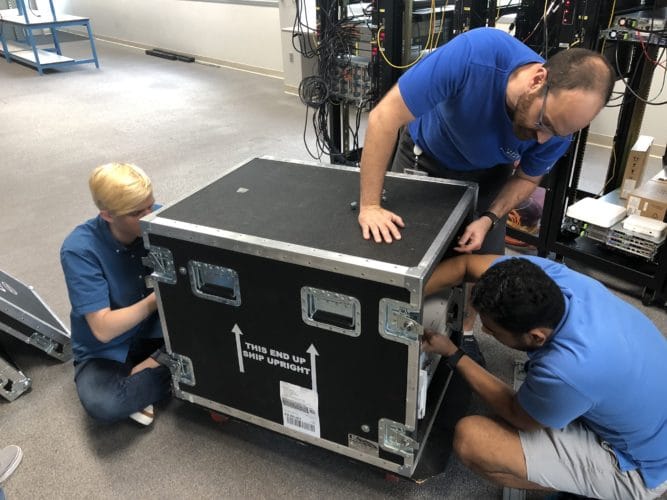Let the supercomputing games begin.
In an around-the-clock race spanning two days, the annual Supercomputing Conference Student Cluster Competition will feature 16 teams of undergraduates tackling real-world computing workloads using NVIDIA V100 Tensor Core GPUs.
There are six new teams for this year — three each from China and the U.S. — taking on an immersive HPC challenge that demonstrates the breadth of skills, technologies and science that it takes to build, maintain and use supercomputers. They join 10 other teams that have competed previously.
The competition challenges these teams to construct their own computing clusters, and then run real-world applications and tests on them with realistic budget, power and time constraints.
A Spirited Competition
The teams will be judged on the benchmarks of their clusters, interviews and optimization of various applications, which range from particle-in-cell simulation used in fusion energy experiments to computer system design simulations that target real-world modeling.
They’ll also be expected to reproduce results from the SC19 paper, “Computing planetary interior normal modes with a highly parallel polynomial filtering eigensolver.”
All the teams will be using NVIDIA supercomputing clusters designed to take on specific tasks already faced by those deploying high performance computing. For the past few years, NVIDIA has supported the competition by donating cutting-edge GPU technology.
Snapshot of the Teams
University of Tennessee sophomore Ria Patel, a computer science major and member of “Team Tennessee,” said her team’s journey to the competition began during a summer internship at Oak Ridge National Laboratory, home to Summit, the world’s fastest supercomputer. While they completed a majority of the preparations over the summer, the team, which hails from multiple universities, has met once a week since then.
“I’m always curious to see how everyone thinks and being able to work with other people who are also interested in the same subjects is really great,” Patel said.
Students from around the world have duked it out during these supercomputer cluster competitions since the Supercomputing Conference in 2007. That first SC07 battle, held in Reno, Nevada, has inspired similar competitions in Germany, China and South Africa.
After participating in several regional competitions, Songlin Jia, a computer science and engineering major at Shanghai Jiao Tong University and a member of “Minuscule Optimization,” said it was time for his team to broaden its perspective to the international scene.
“We want to know what is happening outside Asia, so we can work on new challenges and learn a variety of applications,” Jia said.
Yuzhuo Jing, a computer science major at ShanghaiTech University and a member of “GeekPie_HPC,” said it’s been exciting for the team to explore an unknown area for them.
“We’ve never learned so much hardware and software knowledge before and I think it’ll be very helpful for our careers,” Jing said.

Berra Kara, a junior computer engineering and applied mathematics major at North Carolina State University, said her team took NVIDIA’s courses on CUDA to learn how to use the software for their cluster. The team, “Howling HPC,” said GPUs help provide a performance boost when running these applications.
“We’re using the CUDA software for our cluster, but we didn’t know much about CUDA and there aren’t any courses at our university about parallel programming,” Kara said. “We used online tools like NVIDIA’s classes on CUDA programming to learn and get comfortable with it.”
Looking ahead to the competition day, Pengcheng Xu, an electronics engineering and computer science major at Peking University, said it’s important for the team to do well and, at the same time, have fun with the experience.
“We hope to do our best at the problems, but what’s more is that we hope to enjoy the whole competition process,” he said.
For a behind-the-scenes look at the competition, follow @NVIDIAAI on Instagram.
The full list of the teams include:
- Boundless DAWG (University of Washington)
- Daemon Deacons (Wake Forest University)
- deFAUlt (Friedrich-Alexander-Universität Erlangen-Nürnberg)
- GeekPie_HPC (ShanghaiTech University)
- HammerTime (Purdue University)
- Minuscule Optimization (Shanghai Jiao Tong University)
- NTHUSCC 702 (National Tsing Hua University)
- Peking University Supercomputing Team (Peking University)
- RACKlette (ETH Zurich)
- Tartu Team (University of Tartu, Riga Technical University)
- Team Tennessee (Oak Ridge National Laboratory)
- The Team of Tsinghua University (Tsinghua University)
- Team Supernova (Nanyang Technological University)
- University of Illinois Student Cluster Team (University of Illinois Urbana-Champaign)
- Warsaw Team (University of Warsaw, Technical University of Warsaw)
- Howling HPC (North Carolina State University)
Competition results will be announced on Thursday, November 21.
Related blog: